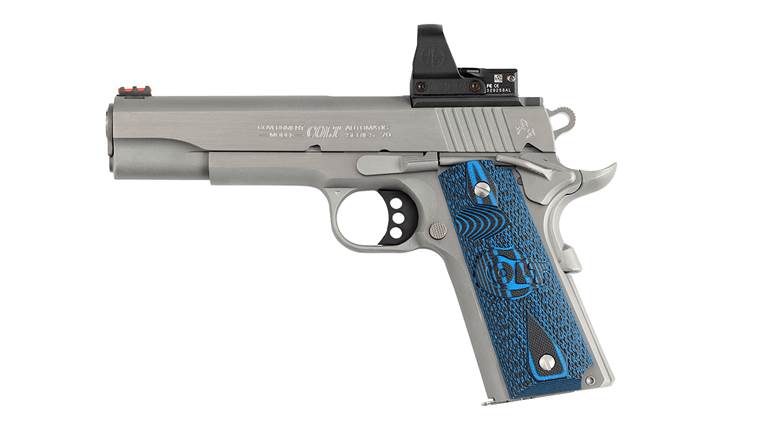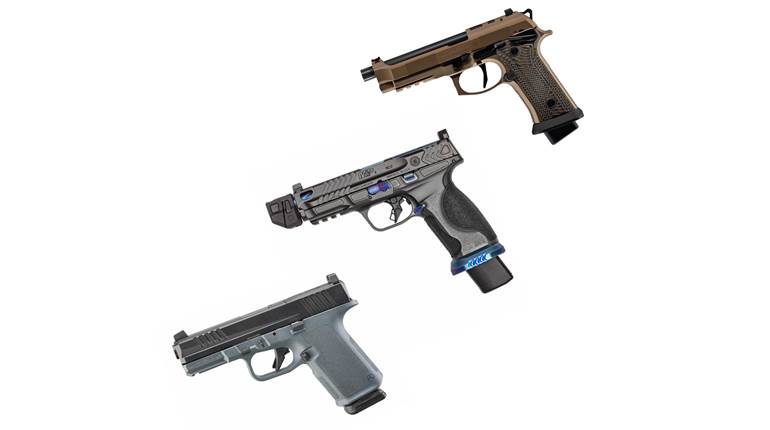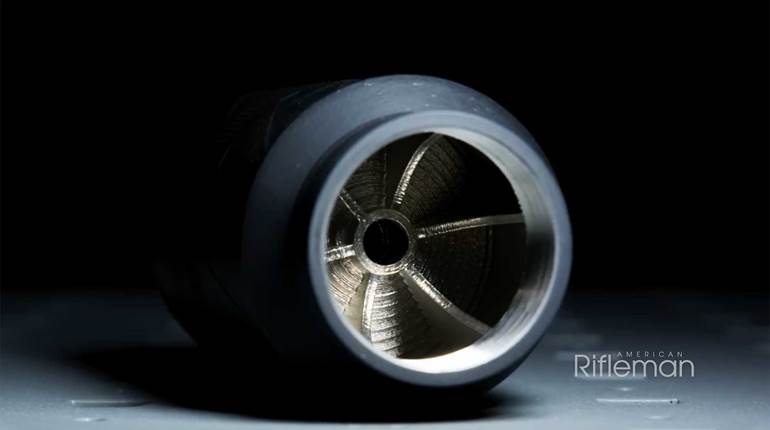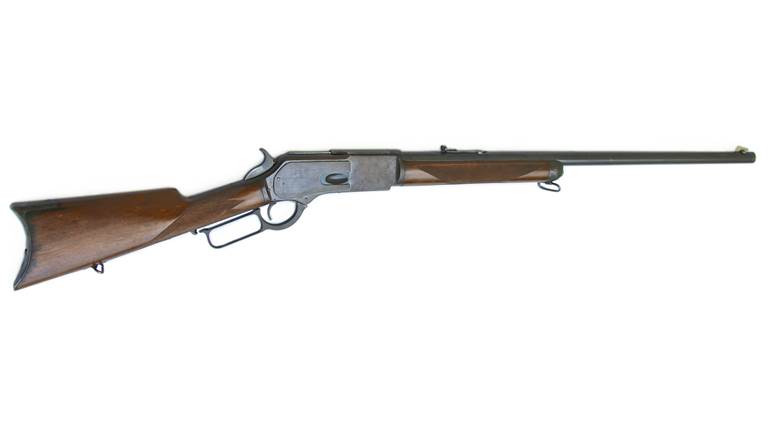
Sometime in 1954, in the American embassy in Havana, a young intelligence officer sidled up to a congressman’s salty, former Marine bodyguard. He wanted to be buddies with the older guy and looked for something in common he might find to start a conversation. Noting an M1911 Government Model in the tough guy’s shoulder holster, he said, “Say, is that a .45? I carried one of those in the war.” It was the perfect entree for him to alert the old man he’d been a combat trooper himself.
But the old guy wasn’t having any of it. He didn’t even bother with eye contact. “Nah,” he said, “it’s a Super .38. Ten shots instead of seven. Goes through a car door, and I figured if I had to shoot it might be around cars. One of our undercover officers used it to good effect last year.”
Then Earl Swagger walked away and lit a cigarette and continued to eye the crowd. It was his job, and Earl always did his job.
As I say, it happened in 1954 in Havana. I know it to be a fact because it’s documented in a novel called “Havana,” which I happened to write. In other words: It happened in my imagination, which makes it real enough for me.
I was using the special, almost cult-like power and reputation of the oft-forgot but hard-loved .38 Super (it was called “Super .38” until at least the mid-’50s) as a way to characterize both men. Young Roger St. Sebastian Evans didn’t know about such a things, and assumed all M1911-platform pistols were .45s; Earl, on the other hand, had given a great deal of thought about which gun to carry on this job, which involved providing security for a congressman who had a tendency to put himself in troublesome places, usually involving women of a certain profession and liquor. Earl knew that in those largely pre-hollow-point days, the Super .38 carried more ammunition (nine in the old Colt magazines, with one up the spout), shot flatter, recoiled less, recovered faster, reloaded just as quick, and fired a smaller bullet at a faster velocity. It was ideally suited for his kind of work, and a hundred or so pages later, he puts it to good use.
But besides its tactical advantages, the .38 Super represented one allure of gun culture that only occasionally gets acknowledged, and yet one that is absolutely fascinating and all but impenetrable to those who don’t feel the pull. That is, it has charisma; it has personality, pizzazz, and vividness. It’s out of the ordinary, beloved by some, aggressively non-generic and it carries information with it. It says—and we love to say this—“I have thought hard about these issues and come to a logical conclusion and made these sound decisions. I am not passive; I am active in deciding about my own defense.”
So it was ideally suited to a novelist’s purposes; it’s what we call a resonant fact, and it’s why my characters never just carry “a gun” but instead have thought about, chosen and most importantly express themselves in their world by virtue of the gun and caliber they chose. Someone once said, “Beware the man who owns only one gun; he probably knows how to use it.” I would append to that: “Beware the man who carries a .38 Super; he knows what he’s doing.”
Thus, it is that the old thing is still around with us today, mainly in competitive venues, or in the safes of geezers such as myself. And it’s why the .38 Super was able to survive a long near-extinction during and after the war; and why, today, nearly all makers of M1911-platform pistols, from the high-end boutique guys to the mass-makers, issue a pistol in its vintage. For certain kinds of shooters—I’m one, having had two before and now owning two—it’s absolutely essential to any collection.
One can see in it the first iteration of what was later considered perfection in another form, the .357 Mag. Its theory was that of the .357 Mag., and not the .45 ACP or the .45 Colt; it was to drive that smaller bullet faster and kill or disable by penetration, while the older guns took the opposite road: to kill or disable by launching a large chunk of lead at a slow velocity and count on mass to conclude the fight.
Elmer Keith told of its invention as well as anyone: In Sixguns, he wrote, “About 1930, due to armored vests and bullet proof glass for autos, the various big gangs over the country gave our police and law enforcement agencies a hard time. Colt answered the problem with their Super .38 auto on the good old model 1911 design. The new arm shot a 130 grain bullet at 1,300 feet and proved an answer to the problem. J. Edgar Hoover’s boys promptly adopted it for their side-arm. It would penetrate bullet proof vests, armored car bodies, if not too heavy, and bullet proof glass.”
That may be true, and to me it was true enough to have Earl Swagger’s son Bob Lee quote nearly verbatim as he explained the .38 Super to a young man in “Black Light.” It’s also the gun he chose to carry in “Night of Thunder,” for reasons exactly like his old man. And it’s the reason the bete noire of the Swagger novels, a nasty opportunist named Frenchy Short, who learned gunfighting from Earl (and later helped murder him) and commanded Bob’s SOG unit on his second tour in Vietnam (sorry, haven’t written this book yet), asked Bob to ship him a box of .38 Super many years later as the caliber was his pistol of choice in Vietnam.
But as great a creation myth as the .38 Super boasts, I have to wonder: Is it true and can it be documented? Keith gives no documentation, and the haphazard, anecdotal nature of his telling raises some doubts. The cartridge was first released in 1929, which means its research and development took place through the late ’20s; and the criminals of that era were all Capones or Capone-wannabes. They mainly killed each other, as the St. Valentine’s Day massacre of 1927 or the various rub-outs of folks named Coll, O’Banion and Schultz point out. The .38 Super held no advantage to the lawmen that were its nominal raison d’etre in 1929; in fact, FBI agents in particular were not even authorized to carry sidearms until after the Kansas City Massacre in June of 1933. I can find no evidence that the Bureau ever “adopted” the Super .38, though certainly this or that agent may have carried one. Remember, the early agents were not gun-savvy, as most were polite law students like Melvin Purvis. It seems far more likely that the chambering was devised to fill another niche in the ammunition marketplace: a hunting and plinking M1911 almost perfect for most game and distant tin cans that offered as well the feel and familiarity of its larger brother but without the bothersome kick.
And as late as 1940, Colt marketed the Government Model Super .38 purely as a hunting gun. “For the big game hunter and the lover of the outdoors, the Super .38 offers an arm of unsurpassed power and efficiency. …Will stop any animal on the American Continent and is a favorite as an auxiliary arm for big game hunting trips,” the company crowed in the 1940 “Shooter’s Bible.”
The crime era that might have required a .38 Super didn’t begin until five years after its arrival, 1934, when the nature of bad behavior changed spectacularly; it became motorized and mayhem-centric. I am talking of course of the crazed years of the road bandits, the professional bank heisters, from low-end mimics like Bonnie and Clyde to the crème de la crème of the gangs, the one headed by John Dillinger. They were desperados who hid in cars and behind bullet proof vests that would stop a slow-moving fatboy like a 230-grain .45 ACP impacting at subsonic speeds, much less a more usual .38 Spl. out of the ubiquitous Colt Police Positive. The .38 Super was as close to ideal for bringing these boys to earth as the ballistics of the era permitted, and it is even said by some that no less a man-killer than Frank Hamer carried one in his take-down of Bonnie and Clyde on May 21, 1934, though since his last nine shots came after the first 159 shots fired that day, it’s doubtful that either Bonnie or Clyde noticed.
But other gangsters noticed. It was with a .38 Super souped up into a machine-pistol (with a Thompson fore grip) that Babyface Nelson used to shoot his way out of the Little Bohemia raid that year, killing one FBI agent. That gun is still on display in the Bureau’s headquarters and it is a slick piece of craftsmanship, no matter how loathsome the purpose to which it was set.
Still, it seems to me it was the .357 Mag. that can truly claim to be the caliber invented to counter the road warriors, with the .38 Super adapted only as a kind of stop-gap measure. A favorite of the FBI agents was the 5-inch-barreled revolver, blued richly with a trigger action that felt like ball-bearings on glass, that rolled out of the Smith plant, a beauty of a gun that put the pill exactly where pointed, with devastating effect. With a 1930s velocity of 1,500 fps and a heavier bullet, it got the job done.
It’s said, too, that the early .38 Supers that emerged from the Colt plant were noted for disappointing accuracy, obviating much of their seeming tactical advantages. The culprit was held to be barrels cut to allow headspacing on the cartridge rim rather than its mouth, which resulted in groups no lawman would trust at any range save the closest. I must say: I did have a 1948 “Super .38” with this engineering “flaw” and it shot well—not great, but well up to my meager abilities. Possibly it wasn’t a minute-of-angle gun, but it was certainly a minute-of-Clyde pistol.
Surpassed by the .357 Mag., then ignored during the war when most civilian gun production halted, the .38 Super nearly died. For a long, long time, only the numbers of guns that Colt had sold in the six years until the coming of the .357 Mag. kept the cartridge in production, but always in small numbers and therefore at higher prices. If the gun had a nesting place, it was in Latin cultures, which is why so many of the guns from the great Ice Age of the Super bear Latin styling flourishes, like chrome finishes, ornate engraving, carved ivory or faux ivory grips. Even today, sites such as Collectors’ Firearms will offer a batch of shiny Colt Supers under names like “El Rey Supremo” or “El Senador.” This is because Mexico commits the most fundamental of gun-restriction follies by banning cartridges in military denominations, like 9 mm Luger, .45 ACP and 5.56x45 mm NATO. (A look at today’s Mexican crime situation almost certainly requires the question: So, how’d that work out for you?)
As a non-military cartridge, the .38 Super became the go-to round for police agencies in Latin countries and, of course, spread rapidly to non-police agencies, i.e., criminals. And for many years, the best .38 Super was loaded by Aguila, the Mexican ammunition maker.
That changed with the coming of IPSC, and it explains why my first .38 Super was a 9 mm Luger Springfield converted to a race gun by a talented gunsmith (now moved on to other endeavors, sadly) named Steve Woods. It was a honey: Woods gave it a crisp trigger, put sunken Bo-Mars atop the slide, sculpted the grip for my not-exactly-gigantic hands, and engineered a brilliantly efficient compensator. When I shot it full out, it sounded like a Sten gun, and everybody else stopped shooting and came to see what I was up to. (I’m not saying I hit much with it, and it was really like putting a Porsche in the hands of a go-karter.)
The reason the .38 Super was such a hit with the folks who ran guns for sport was that in reloads its velocity and weight algebra could be brought up to the threshold of the magic “major” classification that Jeff Cooper built into the sport’s rules to fence out the puny 9 mms, which he felt offered a technical match advantage but not enough fighting seriousness. The Super, by his completely arbitrary mathematical formula, got just over the limit; it was also so highly pressurized that it worked well with the compensators in vogue then, and continued to produce low-end recoil, faster recovery times, and a slight capacity advantage, comically useless to me but of great import to competitors who were but hundredths of seconds apart.
Alas, like so many others—and like the 1948 Super—the Woods gun got away from me and I’m still wondering why. I think I spent the money on beer and fudge. Sic transit gloria mundi. Anyhow, I never gave up my love for the caliber and of late have acquired two examples of it: An S&W Doug Koenig special, a very fine gun; and a Kimber Super Match II, another superb gun—I had to guide through Maryland’s twisted arroyo of gun laws, as they originally ruled it inadmissible. Why? Don’t get me started.
Which leads me to what the gun represents today and for whom it’s good. There is one person in the world for whom it’s a best choice: me. That is because I love the M1911 platform for its reliability and its heritage. It’s like shaking hands with John Moses Browning, with Sam Colt looking on fondly. There’s something so classical in it and so full of history—from Vietnam to Korea to Ranger Hamer to FBI agent Charles Winstead (who used it to terminate John Dillinger as he drew a .380 ACP) to Argonne Woods to Pancho Villa and of course to my old and beloved friends Pike and Dutch—that it seems almost a charged relic, like a great samurai sword; you can hear far-off trumpets, the slap of the leather as it rocked on young Audie Murphy’s belt across Europe, the staccato of alley gunfights, the three shots Winstead fired on July 23, 1934—each time you pick one up.
So I’ll always have a big boomer or 17 lying around, but still I have thin hands, smallish too, and lack those Popeye-forearms that all the truly great gunboys boast. So for my meatless paws, recoil is amplified; that’s why I won’t own or shoot a .40 S&W and launch .38 Spls. in all my .357 Mags. But the .38 Super is perfect for me; it’s classic, it’s accurate (the Koenig Smith even makes me look good!), it’s beautiful, and with Cor-Bon +Ps producing a muzzle energy of 516 ft.-lbs. it’s far more than adequate for any self-defense load.
It has disadvantages, of course. One is the relative rarity of ammunition; the second, a function of the first, is the relative cost of the ammunition. I buy in bulk and even the Grand Duchy of Maryland lets UPS ship it to me at considerable savings over per-box purchases at the few gun stores in my benighted area that stock it. Another disadvantage is a function of the first and second; there being few loads, what do you do if your gun shoots none of them well? Hmmm: One answer would be to reload. Another answer is probably not for all but it always works for me: Use it as an excuse to buy another gun.
Understand and love it for what it is: a cult cartridge with a whiff of romantic history to it, as launched from the most American of platforms. It has a place on the shelf of the safe that began as a place on the shelf of the memory and the imagination. As Pike said to Dutch, “I wouldn’t have it any other way.”






































